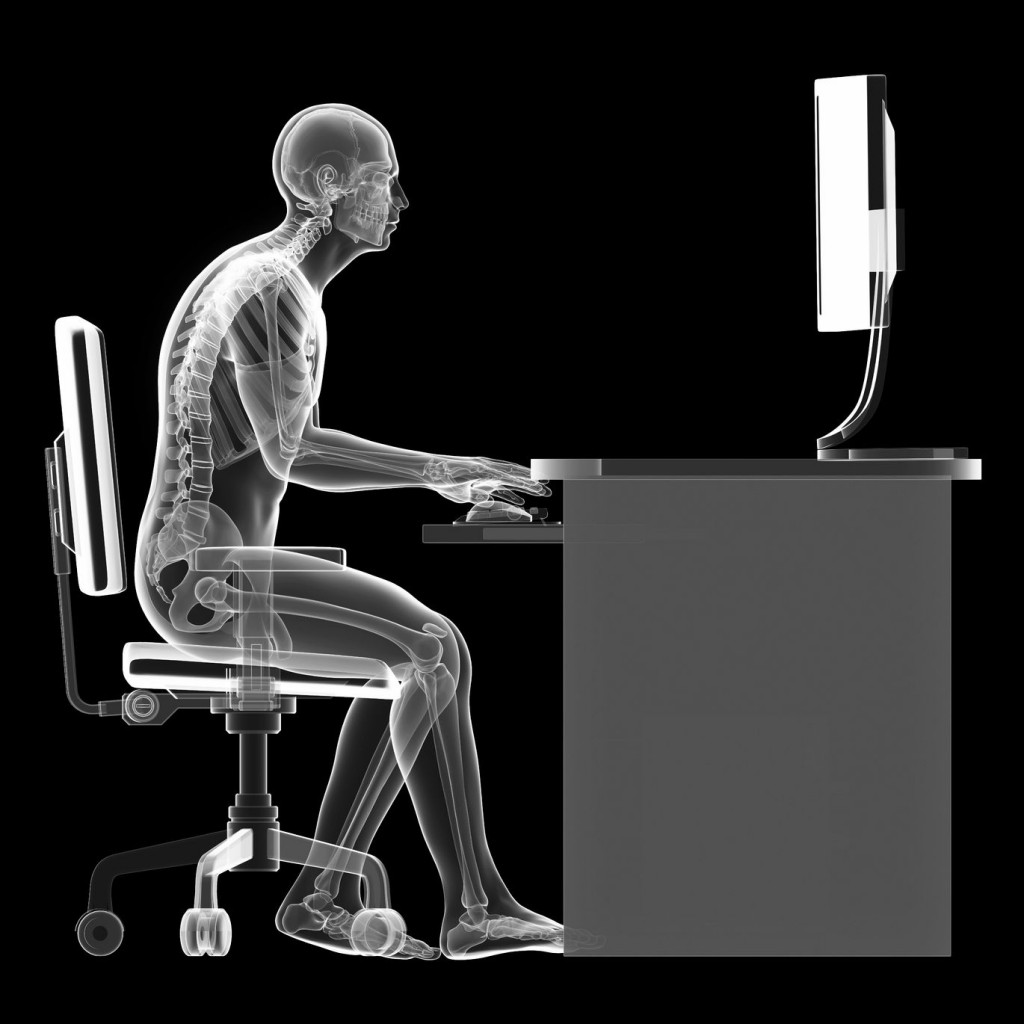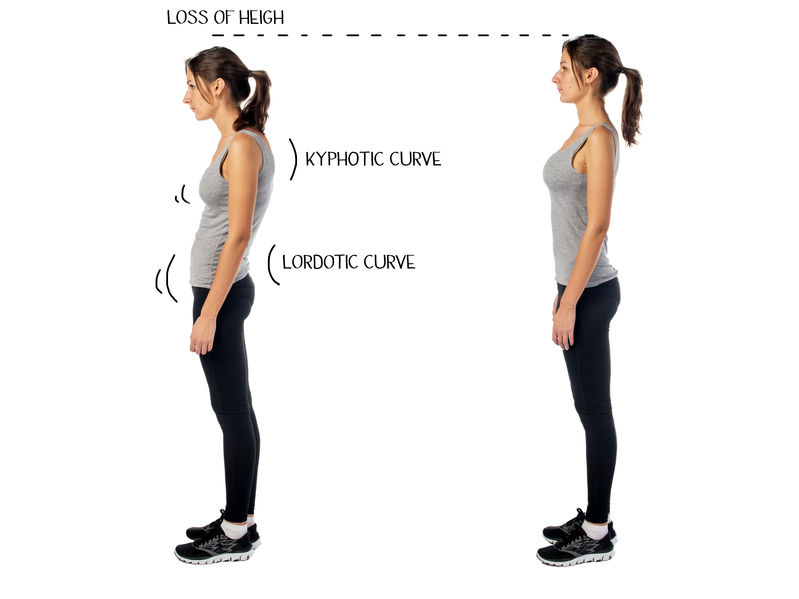Let’s face it, we’re not designed to spend every hour of the day locked indoors, staring at a screen, and desperately tapping away at the keyboard trying to get our work done! Prolonged sitting is no good for us, and sitting with poor posture can further exaggerate things.
Some of us may break up the day by taking a walk or playing a game of five a side at lunch. Others may cycle to and from work or stop by the gym on the way home. These really help keep us in good shape, but what does this prolonged sitting do to our bodies?
 Posture Effects on Low Back and Pelvis
Posture Effects on Low Back and Pelvis
Whilst in a typical seated position:
- Knees are bent at around 90° – This places our hamstrings in a shortened position.
- Hips our flexed at around 90° – bringing our hip flexors to a shortened position.
- Pelvis is tilted backwards – allowing us to relax our core muscles, in particular our abdominal muscles.
Eventually our bodies can adapt to this prolonged sitting resulting in shortened hip flexors (psoas muscle), shortened or tight hamstrings, tight low back muscles, weak abdominal muscles, and weak glutes. Our bodies adapt to this and our pelvis can become tilted forwards, increasing our low back lordotic curve (see pic) .
This drastically effects:
- Core Strength
- Flexibility
- Joint loading and pain
- and can predispose you to injury
Posture Effects on Upper Back, Neck, and Shoulders
Whilst at a desk looking at a screen we tend to:
- Flex our upper back and roll our shoulder forward (slouching) – This can essentially stretch our upper back muscles and our trapezius muscle (spanning between our back, neck and out to our shoulders) and cause shortening of muscles of our chest (pec muscles).
- Extend our neck – to adapt to our upper back postural change. This can cause shortening of the muscles at the back of our neck and weakening of muscles at the front of our neck.
- Crane our heads forward to see the monitor – This can further amplify the effects of extending our neck and place extra loads on joints and muscles to be able to maintain this posture.
Similarly our bodies eventually adapt to this by increasing our mid back kyphotic curve (see pic). This can predispose us to; neck pain, shoulder pain, joint loading, and joint wear and tear.
Posture Effects of Inactivity
Periods of inactivity can also affect our joints and muscles on microscopic level. Ever heard the phrase ‘don’t use it, loose it’? This holds some truth for our muscles and joint range of motion.
Muscles, when not used or engaged can atrophy (waste away), this sounds terrible but really it’s our body’s way of maintaining efficiency and placing resources and nutrients where they’re currently needed. However this does mean if you’re spending prolonged time seated your muscles can change. For 3-5 days bedrest it takes 30 days to regain the muscle and strength lost due to atrophy.
Muscles and joints can also become restricted due to sustained inactivity. Every day our bodies are constantly laying down collagen fibres in an almost random pattern. This occurs; over joints, between muscles, between organs. The purpose of this is to create stability in areas not used much and to allow smooth movement in areas of higher mobility. This also helps maximise the bodies efficiency by creating stability where needed. These fibres get broken down by movement. By spending long periods of time in the same position we’re allowing the build-up of these fibres causing fascial restriction in joints and muscles. Gil Hedley explains this really nicely in a non-scientific way in his youtube video, take a look if you’re not too squeamish but be warned the video does show dissection and may not be to every ones taste. Gil Hedley Video
Postural Ergonomic Help
 Try sitting with your hips flexed at 90⁰, knees at 90⁰ and feet flat on the floor. Have your screen at head height directly in front of you so you don’t have to turn your head to the side. Try to maintain a neutral posture where you are not stretching or straining, and no slouching. This will help minimise loading of joints and strain on muscles whilst sat at a desk.
Try sitting with your hips flexed at 90⁰, knees at 90⁰ and feet flat on the floor. Have your screen at head height directly in front of you so you don’t have to turn your head to the side. Try to maintain a neutral posture where you are not stretching or straining, and no slouching. This will help minimise loading of joints and strain on muscles whilst sat at a desk.
Different seating can help by causing you to engage more muscles whilst seated, especially your core to maintain an upright position. Sit to stand desks will help by encouraging you not to spend too much time seated or standing. Also, by placing your body in an upright position you reduce effects of shortened hip flexors and hamstrings. However, if you are working standing, try not to lean or slouch.
Ergonomic help is great it allows us to make changes to our environment by adjusting factors extrinsic to our bodies. But we do need to take some responsibility for our own health. Think of these as intrinsic factors, factors specific to you and your body.
Intrinsic Factors include:
- Muscle condition – Muscle imbalances, or tight and knotted muscles affect the muscle tissue dynamics. This means strains and pain can be felt sooner as the muscle is not functioning efficiently.
- Joint Range of Motion – Restrictions in our joints can essentially cause us to over work other joints, as we have to compensate for the restriction. This can be a predisposing factor in aches and pains.
- Hydration – Many people don’t hydrate adequately or drink just tea or coffee. Less than optimum hydration means our muscles and joints are not hydrated on a cellular level, if our cells can’t thrive then our bodies can’t either.
- Sleep – There is strong scientific research highlighting the link between sleep deprivation and pain. This is because the majority of our healing takes place during our sleep.
- Stress – Stress plays a massive role in many conditions. It physically effects how pain is transmitted along nerves. It can have drastic effects on tissue dynamics, sleep, hydration, and even apatite (affecting the fuel for our bodies).
Please See our ‘6 self-help tips for desk postural pain‘
If your interested in ergonomics or Alexander technique visit ergonomics.org for a great resource of information.
If you are in pain, or just want some great tips on how you can improve your posture and advice specific to you. Call Pure Health Osteopath Clinic for an appointment. Our Osteopaths will examine your posture, movement and form a treatment plan specific to your needs. Helping you feel great and self manage. You can also visit our Osteopaths even if you are not in pain, prevention is better than cure. Call 01179 000 935 to book an appointment.
